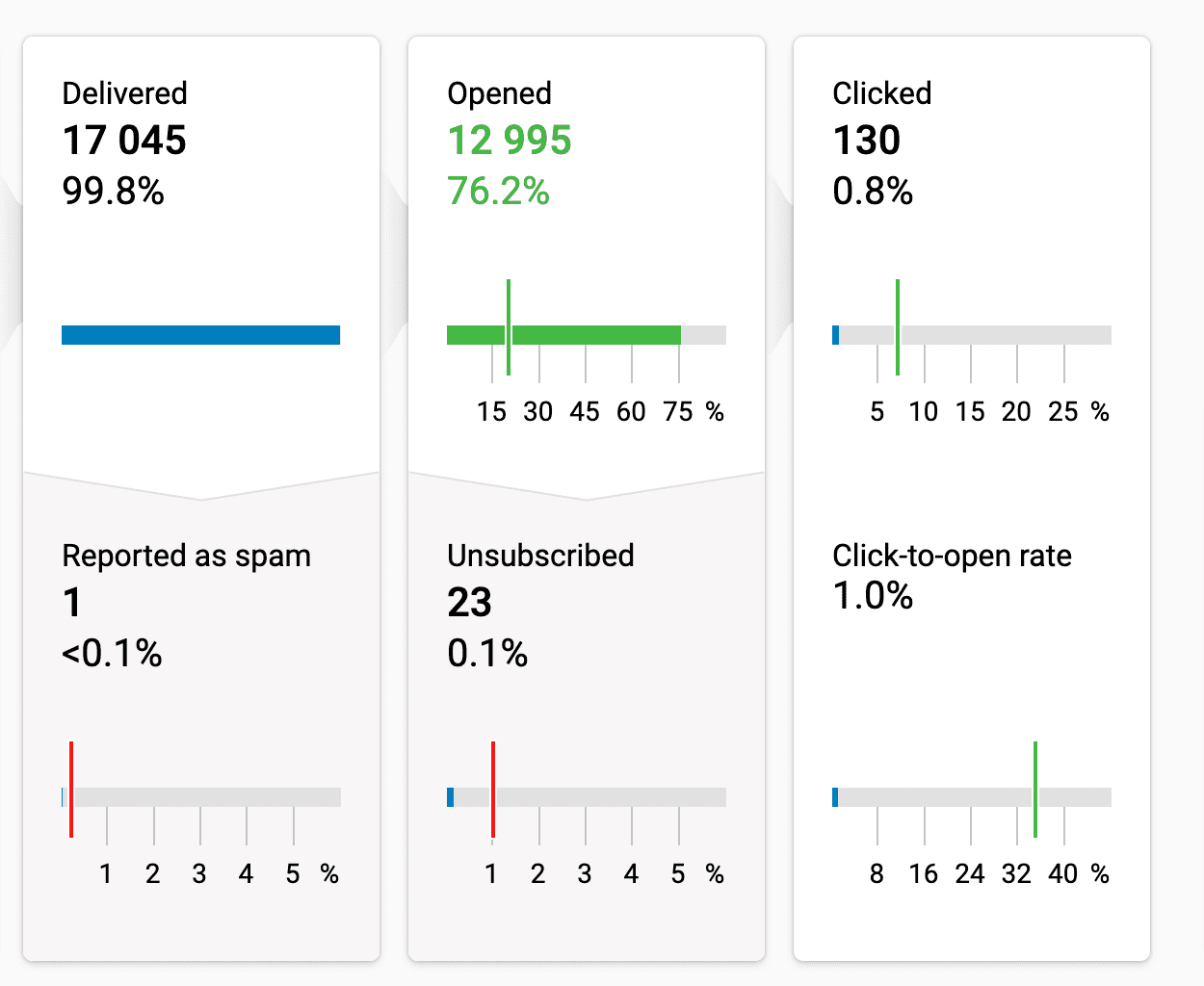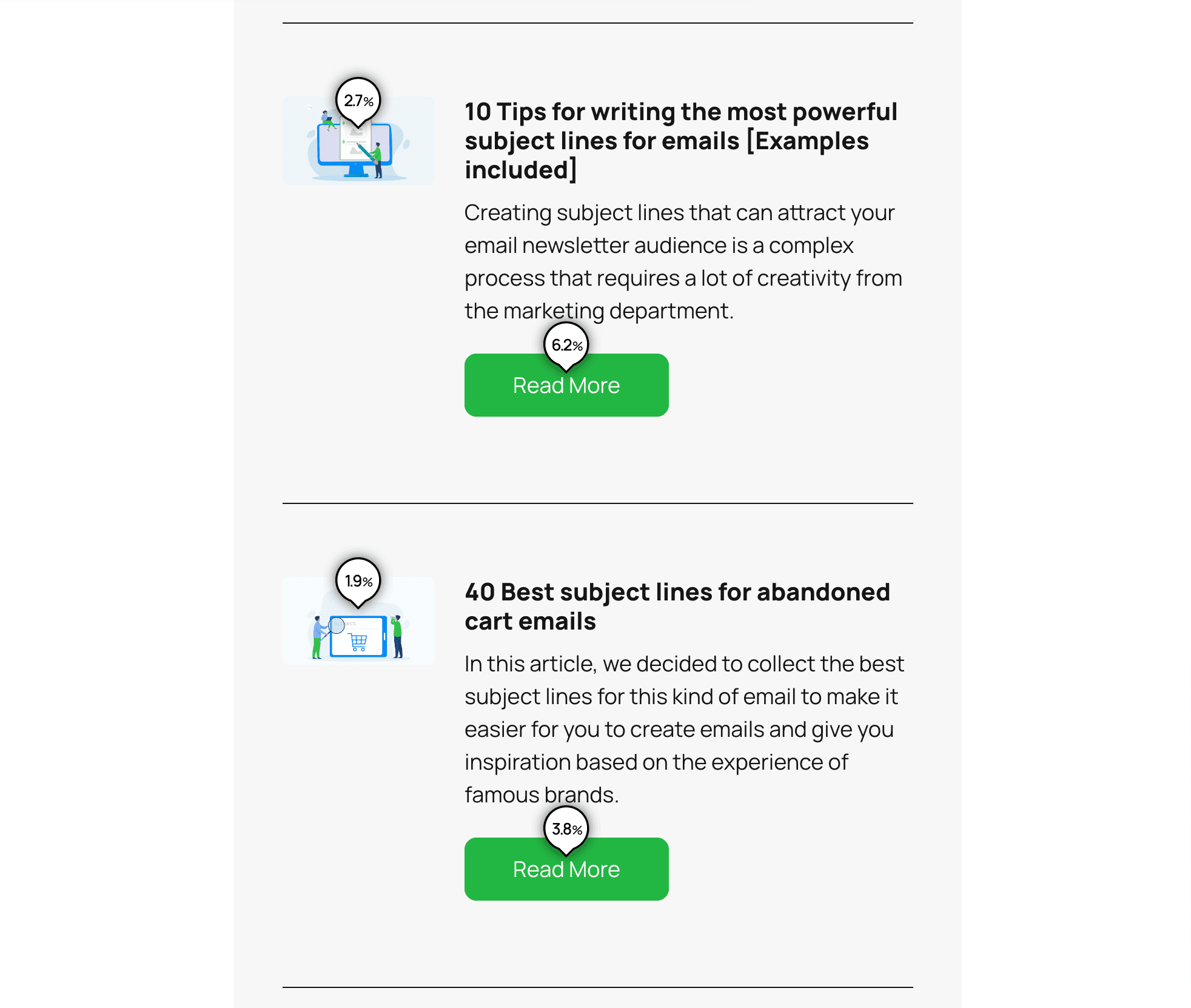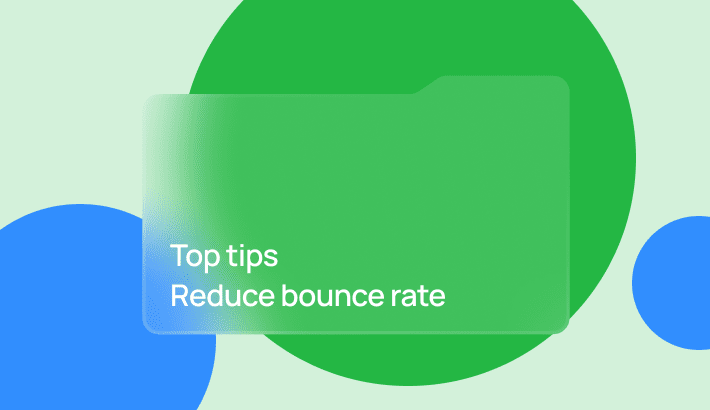Why is email marketing so good? It can measure the results of any campaign with clear numerical indicators. There are quite a few important metrics, but this does not mean that they should be evaluated in the same way. Every email campaign is unique. We send some emails to inform the audience, others to increase loyalty, and more to increase sales.
So, how to properly evaluate the effectiveness of your email marketing campaigns, and what pitfalls should be kept in mind during this process? Let's dive right in.
Key metrics for email advertising campaigns
So, you have created an email sequence and sent it to your recipients. Some time has passed, and now is the time to measure the email marketing effectiveness of your efforts to gather valuable insights.
In order to do this right, you need to be aware of the email marketing metrics to measure the extent of your success. Let's take a quick look at all of them.
Open rate
It shows how many times your email was opened in relation to the total number of delivered emails.
Here's a simple email open rate formula for your email campaigns: divide the number of people who open the email by the number of people who received the email.
Open rate is one of the main indicators of email newsletter effectiveness. Do you want to learn more about Open Rate metrics and what affects them? Check out Stripo and GetResponse's white paper on email marketing performance.
Click through rate
This metric is responsible for a percentage of users who receive your email following the links inside the email.
It’s not enough to just sell a product, send heartfelt emails, or be on trend. The key to a high CTR is content or offer that is interesting to the audience, as well as wrapping it all in an intuitive email newsletter design with the convenient placement of transition buttons.
To calculate click-through rates for your email marketing campaigns, take the number of people that have clicked on a link in your email, divide that by the number of emails delivered, and multiply that number by 100 to get a percentage.
Conversion rate
If we are talking about commercial email campaigns, each email should have a call to action.
The target action can be different: following the link and taking a survey, downloading useful material, registering for an event, making a purchase, and so on. CR shows the percentage of users who not only opened the email but also reached the goal you set.
To calculate your email conversion rate, divide the number of recipients who took the action you were looking for by the number of emails delivered to recipients. Multiply the result by 100 to express the outcome as a percentage.
Bounce rate
This metric reflects how many emails did not reach users. There are two types of bounces: hard and soft.
- Soft bounce — if the reason is temporary. For example, the recipient's email address exists, but for some reason, it can’t accept your email at the moment. Perhaps the recipient's inbox is full, or the server is temporarily unavailable due to problems with internet service providers. As a result, the email can be sent again, but a bit later.
- Hard bounce — if the cause is permanent. For example, the non-existent email address or typos in it.
The bounce rate is easily calculated by taking the total number of bounced emails and dividing that by the total number of emails sent. Then multiply by 100 to get your percentage.
We dived into more detail about email marketing bounce rates and tips to reduce them in our special article.
Unsubscribe rate
The name of this metric speaks for itself and shows how many users have unsubscribed from your email newsletter.
The formula for calculating your unsubscribe rates is to divide the number of unsubscribed users by the number of emails delivered. Then, multiply that number by 100 to get a percentage.
Spam complaints
The spam complaint rate measures how often subscribers mark your emails as spam. Calculating this rate is quite easy. The number of people who mark your email as spam out of the number of people who receive the email is sufficient.
Overall ROI
Email marketing ROI (Return On Investment) is a business's net profit from email marketing campaigns. It indicates how successful your email outreach is, including promotional, transactional, and direct mail.
ROI for your email marketing efforts is calculated by subtracting the initial value of an investment from the end value of the same investment to get a net return, then dividing the net return by the total costs accumulated and multiplying this final figure by 100.

Challenges in measuring email campaign effectiveness through indirect methods
It would seem that you have precise metrics that have clear formulas and clear numerical results. The numbers can't lie. However, this is not quite true.
The results of calculating the success of an email marketing campaign may differ slightly from reality due to certain challenges and situations that you may encounter.
Inaccurate open rates due to images being blocked
Before telling what exactly this challenge is about, it is worth explaining how opens are tracked.
It's a standard practice across the email marketing industry to embed a unique, transparent, single-pixel image into every email. The image pixel is completely invisible and does not impact your email design. When recipients open your email, a call is made to the server to load the email content, including the image pixel. Every time the image pixel is called, it counts as an open.
Email opens can't be tracked when the image pixel can't display. Email image blocking happens for most of your contacts when their email provider doesn't support images or when recipients block images from displaying, or because images use extra data on a mobile device.
As a result, you lose these potential open rates in your final report.
Inability to measure engagement beyond clicks and conversions
Even though there are metrics to determine the engagement of your email campaigns, they still don't tell the whole story. The engagement of your newsletter is also very subjective, and subjectivity is difficult to give any exact values. Perhaps your recipients viewed the email and clicked on the necessary buttons, but the email seemed boring to them, and they are no longer waiting for subsequent emails. In the meantime, you have excellent click and conversion rates in your dashboard.
Direct measurement methods for email advertising campaigns
In addition to the standard metrics that various analytics platforms will provide you, you can also resort to additional ways to measure email marketing effectiveness.
Using unique URLs for different links within the email to track individual clicks
Tracking links are used to manage and measure the effectiveness of marketing activities, channels, and campaigns. Using a tracking link is vital whenever you send traffic to corresponding landing pages or websites from an external channel.
In short terms, a tracking link is a regular URL with tags added to the end. These tags, otherwise known as parameters, indicate where a target audience comes from, what content they clicked through, and which campaign this content relates to.
Adding UTM parameters to URLs to track traffic sources and campaigns in analytics tools
A UTM (urchin tracking module) is a simple code attached to a custom URL to track its source, medium, and campaign name. UTMs acquire the data you need to understand the effectiveness of your email marketing campaigns.
When creating UTM parameters, you establish link-tracking tags that identify the URL’s source, medium, and email campaign name. You can also track individual links by keywords automatically generated to identify each link.
A/B testing for email optimization
For your emails to work flawlessly and your email marketing performance not to decline, they need to be constantly improved. But how do you know what your audience responds best to? The most obvious thing is to make the necessary changes and see what happens. But it's time and money that you want to use wisely. This is where A/B testing comes in.
How A/B testing can help measure the effectiveness of different campaign elements
An A/B test, or split test, is an email marketing research method used to evaluate the effectiveness of an email marketing strategy. You set up two versions of the same email and send it to a small percentage of your subscribers. Option A is sent to one half of the test group, and option B, respectively, is sent to the other half. Based on the selected KPIs, determine the winning option and send it to the remaining subscribers.

The key elements that can be tested
There are many components in an email that you can test to see how they'll work with your future email campaigns. And here are the main ones.
- Sender name. The first thing an email recipient notices when they open their inbox is the sender's name. You can test it by changing employees' names or by replacing them with the company name.
- Subject line. You can test the wording and length of the email subject lines. Whether they are personalized or not, whether there is a question or statement in it, whether it is an appeal or a statement of fact, the number of characters used, and so on.
- Preheader. This is the text that appears after your subject line. Give it a lot of attention because the preheader text clarifies the email's subject and convinces the subscriber to open the email.
- Fonts. After the A/B test, you will be able to determine which font resonates best with your audience and affects the accessibility of your email newsletters.
- Text placement. You can test text formatting and positioning in your email. This also greatly affects the readability of the email and its metrics.
- Overall design. Test color schemes for your email campaigns, the number of visuals, their type, and other related things to see their impact on conversion rate.
Analyzing and interpreting data to measure email marketing effectiveness
In addition to collecting statistics on your email digital marketing channel, you need to analyze the results. Thoughtful analysis of important email marketing metrics is the key to generating new ideas and considering mistakes to improve your subsequent email campaigns.
Segmenting data based on different variables
You should remember that there are no perfect strategies for an email marketing campaign. What works great for one part of the audience may go unnoticed by another. That is why segmenting the received data according to various criteria (age, demographics, past behavior, and much more) is extremely important. Having statistics for different audience groups in hand, you can find a middle ground to meet the needs of as many groups as possible.
Comparing results over time to identify trends and patterns
Running different email marketing campaigns is a constant process of comparing them to each other. With clear overtime statistics, you can identify patterns that are dragging down your email campaigns and those that can boost email marketing KPIs.
Seeing the big picture and comparing it to past results is also essential to spot trends in the market in general and in your niche in particular.
Using Google Analytics to measure email performance
We are all used to the fact that Google Analytics is a website traffic control tool. However, besides website visitors, it will help you shed light on your email campaign's performance. Google Analytics shows what many marketers and business owners care about in the first place — sales information and how much revenue came after your email newsletter.
It can be analyzed in terms of the effectiveness of promotional newsletters and triggers, as well as in terms of individual email campaigns.
Analyzing dashboards in Looker Studio
Looker Studio syncs all your data sources and adds them to a single report. With this tool, you do not need to open Google Analytics, social media reports, timing tables, or CRM in different tabs — everything can be done in this tool. With Looker Studio, you’ll be able to:
- import data from different systems;
- create reports for indicators that cannot be tracked in other analytics;
- edit pages or diagrams, styles, and content;
- use dynamic filters;
- work with multiple accounts;
- view and edit reports with separation of access rights for users.
At its core, it is a convenient and time-saving tool. No matter how many data sources you have, they will all be in one convenient place.

Wrapping up
Measuring email marketing effectiveness is essential if you want your email campaigns to succeed. Each important metric sheds light on further steps in improving your email campaign, conversion rate, and lead generation.
But before you start measuring your email marketing metrics, you need to create emails. Stripo will gladly help you with this task.








0 comments